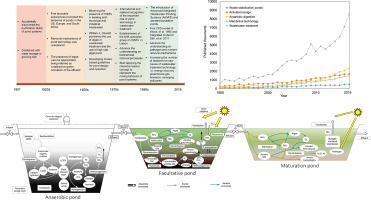当前位置:
X-MOL 学术
›
Ecol. Eng.
›
论文详情
Our official English website, www.x-mol.net, welcomes your feedback! (Note: you will need to create a separate account there.)
Municipal wastewater treatment with pond technology: Historical review and future outlook
Ecological Engineering ( IF 3.8 ) Pub Date : 2020-04-01 , DOI: 10.1016/j.ecoleng.2020.105791 Long Ho , Peter L.M. Goethals
Ecological Engineering ( IF 3.8 ) Pub Date : 2020-04-01 , DOI: 10.1016/j.ecoleng.2020.105791 Long Ho , Peter L.M. Goethals

|
Abstract Facing an unprecedented population growth, it is difficult to overstress the assets for wastewater treatment of waste stabilization ponds (WSPs), i.e. high removal efficiency, simplicity, and low cost, which have been recognized by numerous scientists and operators. However, stricter discharge standards, changes in wastewater compounds, high emissions of greenhouse gases, and elevated land prices have led to their replacements in many places. This review aims at delivering a comprehensive overview of the historical development and current state of WSPs, and providing further insights to deal with their limitations in the future. The 21st century is witnessing changes in the way of approaching conventional problems in pond technology, in which WSPs should no longer be considered as a low treatment technology. Advanced models and technologies have been integrated for better design, control, and management. The roles of algae, which have been crucial as solar-powered aeration, will continue being a key solution. Yet, the separation of suspended algae to avoid deterioration of the effluent remains a major challenge in WSPs while in the case of high algal rate pond, further research is needed to maximize algal growth yield, select proper strains, and optimize harvesting methods to put algal biomass production in practice. Significant gaps need to be filled in understanding mechanisms of greenhouse gas emission, climate change mitigation, pond ecosystem services, and the fate and toxicity of emerging contaminants. From these insights, adaptation strategies are developed to deal with new opportunities and future challenges.
中文翻译:

用池塘技术处理城市污水:历史回顾和未来展望
摘要 面对前所未有的人口增长,废物稳定池(WSPs)废水处理资产难以过分强调,即去除效率高、操作简单、成本低,这已被众多科学家和运营商所认可。然而,更严格的排放标准、废水化合物的变化、温室气体的高排放以及土地价格的上涨,导致许多地方被取代。本综述旨在全面概述 WSP 的历史发展和现状,并提供进一步的见解以应对其未来的局限性。21 世纪正在见证池塘技术解决传统问题的方式发生变化,其中 WSP 不应再被视为低处理技术。集成了先进的模型和技术,以实现更好的设计、控制和管理。藻类作为太阳能曝气的关键作用,将继续成为关键的解决方案。然而,分离悬浮藻类以避免出水变质仍然是 WSP 的主要挑战,而在高藻率池塘的情况下,需要进一步研究以最大限度地提高藻类生长产量,选择合适的菌株,并优化收获方法以放置藻类。生物质生产实践。在理解温室气体排放、减缓气候变化、池塘生态系统服务以及新兴污染物的归宿和毒性的机制方面需要填补重大空白。根据这些见解,制定适应战略以应对新机遇和未来挑战。
更新日期:2020-04-01
中文翻译:

用池塘技术处理城市污水:历史回顾和未来展望
摘要 面对前所未有的人口增长,废物稳定池(WSPs)废水处理资产难以过分强调,即去除效率高、操作简单、成本低,这已被众多科学家和运营商所认可。然而,更严格的排放标准、废水化合物的变化、温室气体的高排放以及土地价格的上涨,导致许多地方被取代。本综述旨在全面概述 WSP 的历史发展和现状,并提供进一步的见解以应对其未来的局限性。21 世纪正在见证池塘技术解决传统问题的方式发生变化,其中 WSP 不应再被视为低处理技术。集成了先进的模型和技术,以实现更好的设计、控制和管理。藻类作为太阳能曝气的关键作用,将继续成为关键的解决方案。然而,分离悬浮藻类以避免出水变质仍然是 WSP 的主要挑战,而在高藻率池塘的情况下,需要进一步研究以最大限度地提高藻类生长产量,选择合适的菌株,并优化收获方法以放置藻类。生物质生产实践。在理解温室气体排放、减缓气候变化、池塘生态系统服务以及新兴污染物的归宿和毒性的机制方面需要填补重大空白。根据这些见解,制定适应战略以应对新机遇和未来挑战。


























 京公网安备 11010802027423号
京公网安备 11010802027423号